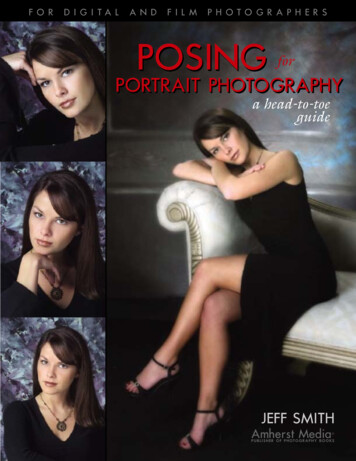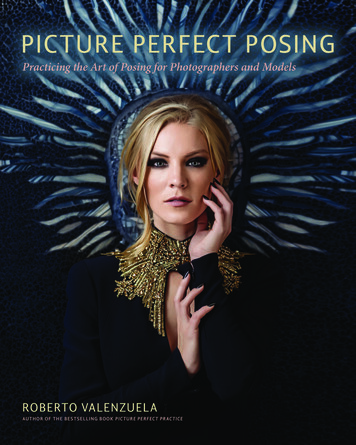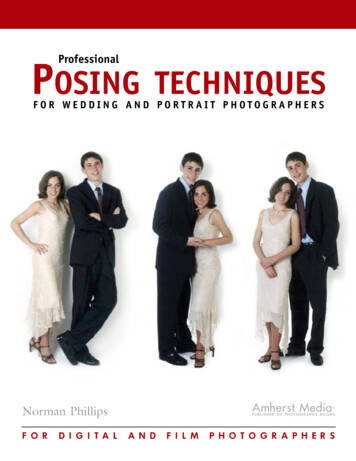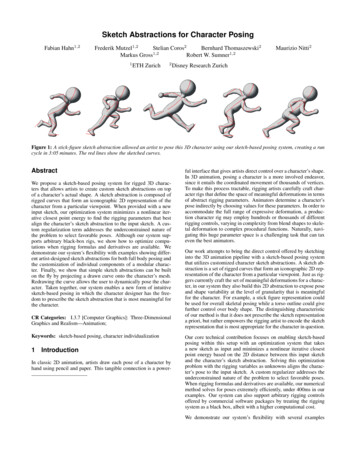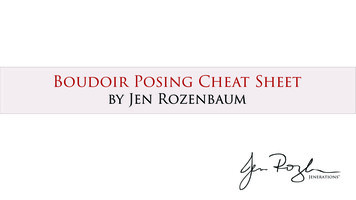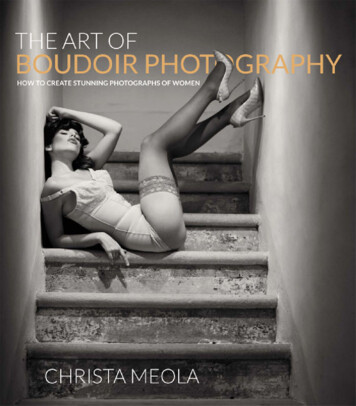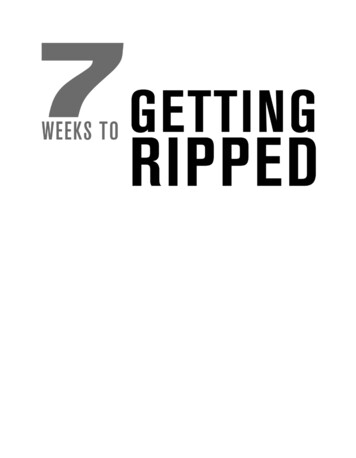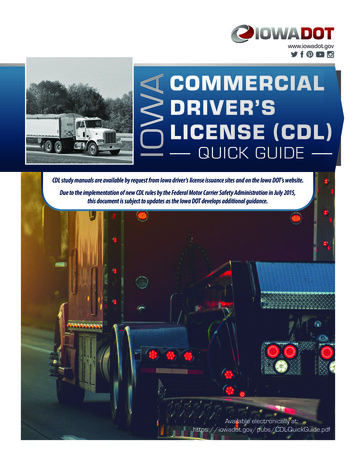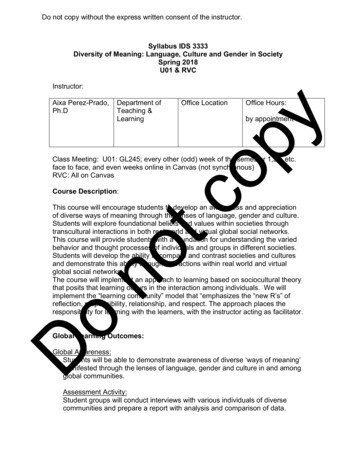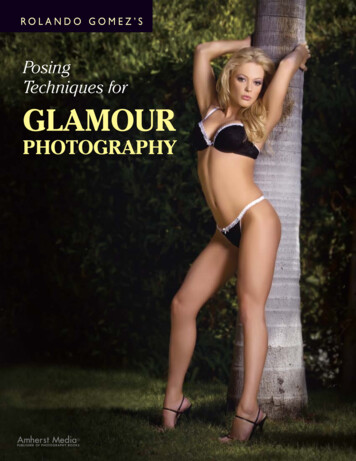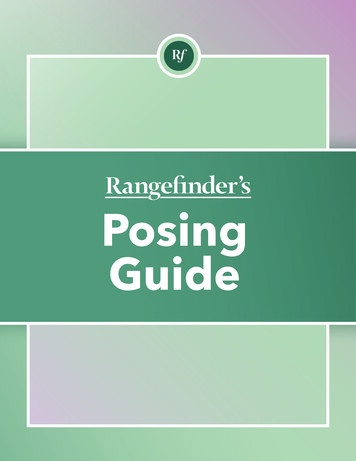
Transcription
Rangefinder’sPHOTO TKPosingGuide
RANGEFINDER’S POSING GUIDEContentsPosing to Unpose: Families 3Posing to Unpose: High School Seniors 5In Vogue: Lindsay Adler on Fashion Posing 7Posing and Prepping Newborns 9Body Language Basics 10Celebrating the Feminine Form 142
PHOTO ELENA S BLAIR PHOTOGRAPHYRANGEFINDER’S POSING GUIDE1Posing to Unpose:FamiliesELENA S BLA IRWhen I am working with a family, my maingoals are to capture love, connection anda little piece of humanity. There is so muchgoing on within any family dynamic and there isso much interaction to be captured. Without a sense of connection, you are simply capturing the pose and the outfits. Perceivable connection gives family photos a human feel and it makeseverything within the photos look more genuine.I do not want my clients to have images that show stiff anduncomfortable (albeit well-dressed) versions of themselves.I want them to end up with images that convey a feeling thatbrings them back to a fleeting moment in time.Once you give yourself the creative freedom to go beyondtraditional, stiffly posed family portraits, you can create artisticand emotive images.When you are photographing families, you are working with realpeople, not models. You need to be able to guide them and directthem so that they look their best and they feel comfortable in front ofyou. I like to say that I guide my clients, but really, I pose them. ThenI direct them to interact, and that is where the moments come from.1DANCE IN A LINEStart by asking the family to stand in a line and hold hands.Then tell them to dance and direct them to look at each otherwhile dancing. Some will really move and some will simply interact.Either way, it yields a connected photo.3
RANGEFINDER’S POSING GUIDE3542BREATHE EACH OTHER INI ask the family to embrace each other. Standing or sitting,I make sure that they are close and facing their bodiestoward each other. Then I ask them to look at each other, and Isay, “Okay, breathe each other in.”As cheesy as that sounds, many parents can relate to thisexercise. I make sure to continue to direct the parents not to lookat me. It’s fine if the child is looking at the camera or facing theembrace of his or her parents. This yields an intimate and connected photograph.permission to move their wiggly bodies. But I always give thekids boundaries. I will say, “You can run and play between thisbush and this rock.” I ask the parents to get close together andembrace, and I direct the kids to move—chase each other, playRing Around the Rosie, or hold hands and run toward me. Iusually shoot this fairly wide in order to include some of theenvironment at the location of the session.5SHOULDER LOVEI like to ask Dad to put one of the kiddos up on hisshoulders, and I direct Mom to walk up and hug him.If there is more than one small child, I will ask Mom to holdthe little one. Any older kids can either hold hands with Momor stand right in front of their parents. Then, I direct Mom andDad to kiss, and sometimes, I ask the kiddo on Dad’s shouldersto lean down and kiss Mom.3TICKLE ONE OTHERAsk the family to sit down as close together as they can.Place smaller children on their parents’ laps. Then ask theparents to gently tickle the kids and to look at the kids as they doso. Make sure that a child’s head isn’t covering their faces.4FREE MOVEMENTNearly every session with young children has a momentwhen the kids have had enough. At this point, I direct thefamily into an open space with good light and I give the childrenElena S Blair is an award-winning family and newborn photographer based in Seattle. She is also an educator who co-ownsboth Blair & Thurston Retreats and Lady Boss Workshops.4PHOTOS ELENA S BLAIR PHOTOGRAPHY2
RANGEFINDER’S POSING GUIDEPosing to Unpose:High School SeniorsBY PA IG E RA MS EYF1WALKINGYou should start with movement. Blast some music and beginwith a walk. You can tell them, “Walk like you’re Tyra Banks,” or,“Walk big, swinging your arms,” or, “Walk as if you’re on a tightrope.”You can have them try this a couple of times. Have them walkforward and backward.1As they walk, remind them to stand tall and push their shoulders back and down. They can keep their arms swinging at theirsides if they aren’t holding anything. Or, have them walk holdingthings like balloons or a dog’s leash. This helps them feel moreconfident because they’re not thinking about what to do with theirhands.Tell them to start with their eyes down and then as they walktoward you to lift their eyes to the camera. Try this with a smilingor neutral expression, and let them try it several times so that theycan get a feel for it. Ask for loving or joyful eyes (instead of a “Smileat the camera!” directive).hands in pockets, put hands on hips, touch their collar bone orplay with their hair. You can also have them hold something again.Hands are important to consider, as a lot of people tend to carrytension in their hands. If you notice someone with tense hands,ask them to make a tight fist and then relax their hand. Tell them,“Pretend like you’re caressing a baby’s forehead,” which soundssuper strange but helps them look more natural. And if they’retouching their hair or face, ask them to make “soft touches,” sothey aren’t smashing their hands in their pictures.Give them a variety of expression prompts. Tell them to giveyou five different expressions. They can be any expressions theywant. Give them a minute to think about it, then go straight intoeach one. Make sure to encourage them and respond with enthusiasm, as that will help them commit to the idea.Twirling or spinning is another great standing pose. If a clientwears a long flowing dress, have them hold one side and swayback and forth. They can also hold both sides and spin in circles,either looking at you or up or away from the camera. Whateverthey do, ask for loving eyes or a confident gaze.2STANDINGIn standing poses, take into account your surroundings.Can you lean up against a wall? Look for symmetry. Canyou stand in the center between two columns? Consider their feet.Have them place one foot behind the other, placing their weighton the foot in front. Have them square up to the camera and thenturn 45 degrees from the camera. They can cross their arms, put5PHOTO THE RAMSEYSor fun and natural portraits, there is a balanceto strike between giving too much direction andnot enough. Telling high school seniors to stand thereand “do their thing” while you click the shutter makesthem doubt every move they make. Break down a pose into everymicroscopic detail and you’ll destroy their confidence.Here’s our secret to natural-looking images: I do pose my clients. I pose them in a way that is flattering for their body, and onceposed, I give them things to do within that pose, and that is howI create natural looks. A pose on its own is lifeless until you givemeaning to it through action.Here are three poses I use, and they are how I get a variety ofnatural, unposed looks that help my seniors feel confident. Withinthose poses, I focus on the following: posture, expression, handsand movement.
1PHOTOS THIS PAGE PAIGE RAMSEYRANGEFINDER’S POSING GUIDE23SITTINGIt doesn’t matter how your seniors are sitting and it doesn’t matterwhat they do, but have them point their toes. This is so important.Extending toes helps elongate legs and upgrades your image. It helpsespecially if they’re seated on something, like the edge of a table or stairs.In posing girls, whether seated or standing, my go-to pose is to bringtheir chin to their shoulder. This is a feminine pose that looks confidentand joyful because it looks so relaxed. Then, direct their eyes down.Ask them to breathe in and on the exhale look back at you with loving eyes. This translates into a smile and genuine expression becausethey’re relaxed. They can play with their hair, sweep their hair back,laugh into their shoulder, hug themselves or play with their jewelry.The most important part of looking confident is that they feel confident, which is why you need to encourage them. Whatever you aresaying should be genuine and kind. Remember that your energytransfers to your client. If you come in feeling rushed, hectic or unsure,that will hold them back from feeling confident. Double-check yourbag before leaving to make sure you have the gear you need, andarrive early. Exude confidence during the session. Remember that itis 100 percent about the person in front of your camera. Make themfeel special, confident and beautiful. Because in the end, that’s whatthey are.Paige Ramsey is one part of a Houston-based duo with her husband andbusiness partner, Wil. She photographs seniors as well as engagementsand weddings.63
RANGEFINDER’S POSING GUIDEIn Vogue: Lindsay Adler onFashion PosingBY LIND S AY A D LERWhile I now work as a fashion photographer in New York City, I actually beganmy photo career as a portrait photographer in a small town in upstate NewYork. I felt deeply inspired by fashion imagery and eventuallydreamed of making the move to the “Big City,” so I began topractice my fashion techniques on brides, maternity subjectsand high school seniors.dress or the subject caught mid-step. These will help transform aportrait from a simple still to an energetic moment in time. I try toadd movement as often as I can to full-length shots in particular toavoid stagnancy.But adding movement can get complicated. I’ve often found thatwhen a subject moves with spontaneity, many of the more flatteringelements of posing start to fall apart. I tend to carefully directmovement instead of just having my subject twirl or dance around—for me that almost never works out. (Tips in the sidebar to the righttell how to incorporate movement intoa pose while still maintaining control.)ADD MOVEMENTThere is nothing wrong with a subtlerpose, but movement will result in amore engaging image. Many fashionshoots infuse an element of movementto make a scene look more dynamic—the flow of the hair, wispiness of thePHOTO LINDSAY ADLERI saw my work take a turn for the better as bit by bit I infusedmore elegance and impact in myimagery. Now when I shoot portraits,I treat them the same as the fashioneditorials I shoot for major magazines,carefully planning out all elementsof the shoot from concept and colorpalette to lighting, wardrobe, makeupand posing.Today’s high school senior isconstantly bombarded with visualsfrom the fashion world, whether bycelebrities they follow on Instagram orin the pages of Vanity Fair. They don’twant their poses to be overly rehearsed,static or traditional; they want moreof the excitement and glamour thatthey’re seeing in contemporary mediaand from figures they admire.To bridge the worlds of fashionand senior portraiture, here are someconsiderations to put into practicewhen you’re posing high schoolers withfashion flair.ABOVE: Inthis more dramatic and theatrical pose,I had my subject lift her left leg and “fall” slowlythrough the step, making it easy for me tosnap a frame. We tried several versions withthe knee lifted to various heights and thearm in different positions.7DON’T FORCE WHAT ISN’T WORKINGThere are lots of places to get inspiredby fashion posing. Ads, magazines andimages on Pinterest provide a plethoraof resources to flood your mind withposing ideas. I recommend beginningyour shoots with a few tried-and-trueposes that you are comfortable with,and then once you’ve gotten some“safe shots,” bring a few more creativeposes to create more unexpectedimagery.One word of warning: If you areinspired by a pose but it’s not working,don’t force it.Everyone has a different body typeand shape, and not every pose will beable to translate to your subject. Bringseveral pieces of inspiration to helpyour subject channel the spirit of thepose and mood, but don’t expect themto look exactly like the model doesin that pose (remember that femalemodels in most magazines are size0 to 2 and a minimum height of 5’8”).Keep in mind that teenage subjectscan be a little awkward or unfamiliarwith their bodies and struggle to follow
RANGEFINDER’S POSING GUIDEPOSE WITH A CLEAR CONCEPTThere is no clear and definitive definitionthat encompasses what fashion posinglooks like. It’s more about conveying amood or fundamental cool with a posethat can be soft and subtle, dramatic andaggressive, and everything in between.What you’ll notice in most fashioneditorials is that every element of theshoot works together to support anunderlying theme or concept. Is the shootPHOTO LINDSAY ADLERyour posing direction, so complicatedposing is usually not the right approach.However, you shouldn’t necessarilyabandon a pose instantly. You mayjust need a bit of time (and betterunderstanding of posing) to get theshot to look right. Experiment with howposing meshes with a particular cameraangle, perspective and lens choice—they all work in conjunction to createa flattering pose. Just like no one poseworks for everyone, no single cameraangle is right for every body type.Remember to stay positive. If youstruggle and make them feel likethey are letting you down, everyoneloses. Work with the pose a bit, thentry something a tad different until youachieve something that flatters thatindividual.ABOVE: Theslight lift of the back foot(suggesting movement) was achieved byhaving the subject bounce back and forthfrom one leg to the other.meant to be dreamy and ethereal, orglamorous and theatrical? The lighting,styling and posing should all fit thetheme and mood.Many photographers have a visionof what they believe fashion posingis—hands on hips, arm draped over thehead. Don’t use a cliché as your go-to.Think of it this way: If you are shootinga soft, dreamy shoot, why would youput the subject’s hands on their hips?That creates right angles and a moreaggressive stance, when you’re actuallygoing for the opposite.One way to think about fashionposing is not about specific poses thatyou see all the time, but instead howa pose can reinforce the central ideaabout the shot you are trying to make.It’s not just a headshot pose meantto create flattering angles of the face.Think about what more can you do withthe body to be emotive or reflective ofthe concept.Lindsay Adler is an educator andfashion photographer based in NewYork City. She’s penned numerousbooks on lighting, posing and shootingfull-figured subjects, among others.Learn more at her educational site,learnwithlindsay.com.or focus that way. The bounce step allows me to capturemovement in the clothing, feet and hair, and I’m still able toachieve variety from bounce to bounce. I’ll say, “Great, nowbounce again but this time, lean your chest slightly forward,”or, “Looking beautiful, but this time, I want you to relax yourback hand a bit more and give me a laugh.” It is much easier to“reset” and try something different.MOVEMENT TECHNIQUES1. THE FALL-THROUGH STEPWhen I want a more dramatic pose (like a knee lifted up),I use the fall-through step. I invite the subject to lift theirleg and slowly fall through the step. This way I have severalopportunities throughout the pose to capture a moment sinceit is slowed down and exaggerated. For each step I can makesubtle changes. Be sure to have the subject avoid leading withtheir stomach; tell them to elongate through the top of thehead and lead with the chest for more flattering results.3. THE WIND-UPWhen you have your subject twirl around freely, the resultscan be disastrous—they can get dizzy, step out of ideal light, ormake it nearly impossible to capture a frame where both theirbody and expression look good. Trust me, I’ve tried it. Instead, Ihave my subjects “wind up.” I start by posing roughly whereI want the hands, face and body to be and then ask them tokeep their feet in the same position, twist their body around andsnap back into place. I get movement, some spontaneity, buta lot more control.2. THE BOUNCE STEPIf I want the subject to look as though they are mid-step, I invitethem to bounce back and forth from one foot to the other. Ido not have them walk across the frame or toward the camerabecause I find it much harder to capture the ideal movement8
RANGEFINDER’S POSING GUIDEPosing Prepping NewbornsBY A NA BRA NDTWhile newborns tend to look cute no matterwhat pose or props they’re in, California-basedphotographer Ana Brandt has a way of makingthe tiny bodies look particularly precious. Youmay have seen Brandt at WPPI 2016 hosting two hands-on workshops and also presenting “The Art & Business of Pregnancy andNewborn Photography.” Brandt also owns the Belly Baby Lovestudio in Tustin, California, and offers educational workshopsacross the U.S. Here, she offers her tips on how she poses miniature humans in a way that’s safe, comfortable and downrightadorable.the head up on one side. I will tilt my camera down toward thehead to achieve this angle.extra tip: I always keep a heater close by for warmth as wellas a baby shusher, which are essential for newborn shoots.Ana Brandt has been photographing newborns and pregnancy inher California studio for over 17 years.51WHEN SHOOTING FROM THE SIDE, BE EVEN INHEIGHT WITH THE BABY.I tend to pose my newborns on a Paloma Shell beanbag andshoot straight to the baby. I like to sit on a yoga ball so I am even inheight with the beanbag.2WHEN SHOOTING FROM ABOVE, STAY ABOVE.Too many photographers squat down and end upshooting “up the nose.” If you are shooting into newborns’nostrils, it won’t look amazing. Instead, stand right over the baby.I shoot my above shots with a Canon USM 24-70mm II lens thatallows me to stand flat on the floor and shoot over a newborn. If Iwere using a fixed lens, then I would have to climb on something,which can be a safety hazard. (Note: When I do need to stand ona ladder, I have an assistant helping me.)334DON’T UNDERESTIMATE THE FEET SHOTS.Even if a baby is crying, you can give them a pacifier to calmthem down and capture feet images. It is most parents’ go-toimage when creating announcements.5PHOTOS ANA BRANDTSTART WITH A WRAPPED BABY.Whether the baby is on the floor with a head supportor in a basket, I know if the baby is wrapped, it’s aguaranteed shot. Even if a baby is awake, they are usuallymore settled if wrapped, which also helps me achieve greatsibling photos.WHEN SHOOTING FROM AN ANGLE, KEEP THEHEAD HIGHER THAN THE BODY.I tend to curve my babies in a banana shape, curving9
RANGEFINDER’S POSING GUIDEABOVE, LEFT TO RIGHT: Theslightest change in a facial expression can completely change the emotion in your image. Can you see how justchanging the eye tension makes the subject look bored, connected or angry?Body LanguageBasicsBY DA NIELLE LIBINEBefore humans evolved into speaking beings,we communicated with each other throughgestures, sounds and expressions. This modeof communication is commonly known as bodylanguage, and our brains learned how to recognize emotionslinked to different behaviors so we could survive and livetogether. As it turns out, body language is trusted 14 timesmore than spoken words. When you feel an emotion, yourbody instinctively moves in response. It’s essentially a physical reaction that happens without a filter. And this is where itgets really interesting for us photographers.subject look angry, sad or disgusted and can impact the overallfeeling of your portrait.Don’t Say Cheese!Real happiness doesn’t happen in the lips or mouth, but aroundthe eyes. When humans feel real happiness, it’s the musclesaround the eyes that pull up the cheeks, not the mouth thatpushes them out. We can identify a fake smile by the absence ofaction in the eyes.Why do we want to avoid fake smiles? Because what a fakeor tense smile says about the person in the image is that theyare not being honest, that they are uncomfortable or evensubmissive.An emotion can’t be faked and a person has to really feel it forthe image to look genuine, so if you want a real smile, you needto help the person to actually feel that emotion on the inside. IMICRO EXPRESSIONSWhen our bodies react through movement, they can be bigmovements with your body or smaller movements with yourfacial muscles; the slightest tension in the face can make your10
RANGEFINDER’S POSING GUIDELEFT: Theway we angle our bodies and faces toward or away fromanother person is one of the most important indicators of howpowerful and confident we feel, and also indicates how we feelabout the person we’re interacting with.PHOTO DANIELLE LIBINEmost vulnerable parts of the body, we’ll only leave it open andunprotected when we feel safe and comfortable. When we’reuncomfortable or don’t like someone, we start to pivot away asour bodies get instinctively ready to fight or flight. The way youuse this in your poses can drastically impact the feeling of powerin the image.FrontingTo make a person appear confident, powerful and trustworthy inyour pictures, you will want to shoot them straight on. However,this presents a particular challenge in photography because weoften ask our clients to stand sideways to create a more visuallypleasing image.At this point, it’s important to know the objective of the image,and to choose what’s more important: the feeling of power ormaking a more pleasing image. If you’ve been hired to create animage for a client, it’s important to understand their personalityand the objective for the image so you can adjust the amount offronting to match the level of power they want to portray.BODY LANGUAGE IS SPOKEN INOUR POSES, AND WE CAN USE THISKNOWLEDGE TO POWERFULLYCONVEY EMOTIONS THROUGHOUR PICTURES.PivotingA slight pivot can still convey a certain amount of power,especially if the posture is good and the expression is confident,but the more you pivot the body away from the camera, the moredefensive or low power the person is going to appear (versushigh power, which looks more open and confident).Not all pivoting is defensive, however. A woman who is flirtingwith someone will turn her body sideways and look at themover her shoulder. This is a pose that we see a lot in glamourand boudoir photography for this reason. But because nothingis clean-cut with body language, she can also communicatedisdain at something or someone she doesn’t like with this samemovement; the difference will be in her expression.It’s also very important to pay attention to pivoting whilephotographing groups of people. When people stand in groups,they will naturally pivot toward the people they like and awayfrom those they might not. If you want to avoid the individuals inyour group looking disconnected from each other, you will wantto pivot them slightly toward each other to create a nice sense ofconnection in the image.The same goes with couples during engagement andwedding sessions; if you want to create a sense of love andconnection between them, always keep their bodies pivotedtoward one another, even slightly. If you want to have somedistance between them, or their bodies facing away from eachother for aesthetic reasons, make sure there is a lot of connectiongoing on elsewhere in their bodies—especially their eyes—otherwise the body language will communicate distance or evendistrust between them.ask my clients to think of something that makes them happy—aperson, an object, a food, a memory—and observe their facesas I run through the options. As soon as I see that little tensionaround the eyes, I know we have it. At that moment, I ask themto share that thought with me and we’ll use that word during theshoot to get a real smile every time.Engaging the EyesWhen we are actively engaged with another person or activity,we squint slightly by tensing our lower eyelids. We change theshape of our eyes in this way so we can focus better (just like theaperture in our cameras), and on a non-verbal communicationlevel, this indicates to the other person that we are activelyengaged with them. On the other hand, when we are bored orscared, our bottom eyelid drops and this makes us look lessconfident and lower power.When working with someone to create that confident look, Ilike to help them connect to a moment in their lives where theyfelt really proud of what they did; I see that lower eyelid come upautomatically as soon as they have connected with that thought.I try to avoid telling people to squint to get this resultbecause—just like with happiness—they might try to fake it andend up appearing angry instead. When we squint, we do bringthe lower eyelid up but also push our upper eyelid down, andthis is what our faces do when we are angry.Angular PosingBecause our torso holds all our vital organs, making it one of the11
RANGEFINDER’S POSING GUIDEor even crossing their legs tightly when standing or sitting.PICTURED: Tocross ornot to cross arms inpictures? It dependson what messageyou want to convey.PHOTO DANIELLE LIBINECrossed ArmsTorso-shielding gestures occur most often when a person isfeeling defensive or uncomfortable, and also to indicate that theyare not open to discussion. Whether it’s arms folded across one’sbody, buttoning up a jacket, holding something in front of theirtorso or straddling a chair, these gestures are initiated to putsomething between ourselves and a situation or a person.People often argue that they don’t feel defensive whenthey cross their arms, and this is explained by the fact that thissoothing gesture releases oxytocin and makes us feel calmer.And that is exactly the point. Any pacifying gesture highlights adiscomfort of some sort, and will come across as low power.But what about crossing your arms in business portraits? Isn’tthat a powerful sign of a successful businessperson?Just because we are used to seeing this image everywheredoesn’t mean it’s conveying the right message. We have becomeaccustomed to these images and have stopped questioning theirvalidity.Of course, people can also cross their arms when they arecold, to relieve pain, or to indicate that they are not open todiscussion, but no matter the reason, this is not an open andconfident expression.Let’s take it out of the context of photography. Think aboutthe last time you were having an open and positive discussionwith your friends. When you were happily out on a date. Whenyou were trying to convince someone about a subject you’repassionate about. Did you cross your arms? Think of the peoplegiving powerful presentations on stage. Do they cross theirarms? When we’re looking to create a confident and open imageof someone, we want to stay away from shielding body languagecues.So when do we want to use crossed arms in photos? Thereis no right or wrong body language; it’s just a language thatconveys an emotion, and it’s a great cue to use if the emotionyou want to convey is one that happens when humans do crosstheir arms, like in the following:This is also true for the face. As photographers, we like topivot the face slightly as it creates and shows a nice jawline(which is also rooted in non-verbal communication, as this area ofthe body indicates our hormone levels). As soon as we pivot thehead sideways there is another cue that enters the equation, andthe way we tilt it will also create a different meaning.NEGATIVE BODY LANGUAGELike with any other language, body language conveysinformation and emotion. While there is no “wrong” bodylanguage, some cues can be linked to negative emotions orlevels of discomfort, and you’re going to see them in your clients’bodies (and therefore your photos) as you interact with them.Pacifying and Blocking GesturesRubbing or pressure movements are called pacifying gesturesand are meant to calm down the brain when we are feelingdiscomfort by releasing a hormone called oxytocin.You will observe this when a woman is playing with hernecklace, rubbing her arms or legs, or a man is playing with hisclothes or squeezing his fingers together. Another place to lookfor pacifying gestures is the mouth; lip pressing and licking, andtongue movements pressing inside the cheeks or lips show highlevels of stress.Take any of these as a sign from your clients that they areuncomfortable, and this might show up in your pictures.We implement blocking gestures by putting somethingbetween ourselves and an uncomfortable situation. Crossed orclosed arms are the most obvious ones, but the person mightalso be holding something like a bag or a laptop in front of them,1DEFIANCEYou’ll see this behavior as a characteristic in children whodon’t want to do something, or in two people disagreeing ona subject. Pair this one with a higher chin and squinting eyes toachieve the perfect defiant look.2NO DISCUSSIONPeople will also cross their arms to indicate that they are notopen to discussion anymore. An interesting study found thatwhen our arms are crossed, we are actually less open to hearingwhat other people are saying. If your client wants to show thatthey are not open to discussion and it goes with their personalbrand, or their profession, then this is the perfect pose to adopt.12
RANGEFINDER’S POSING GUIDE3BIGGER BICEPSAlthough not linked to an emotion, crossed armsare also favored by portrait photographers whenshooting male subjects because it’s an easy way tomake their upper arms look bigger. Simply get yourclient to make fists, place them under their bicepsand tada! Bigger biceps.Note that if the objective is first to make your clientlook strong and virile, and we don’t care too muchabout openness, the crossed-arms pose will trumpthe closed body language message.MIRRORINGDanielle (Dee) Libine is a Swiss-Canadian portraitphotographer and a certified body language trainerwith Science of People. Running photo studios inSwitzerland and Hong Kong allowed her to test herapproach with a wide variety of clients, and she wenton to write and publish A Photographer’s Guide toBody Language to share this knowledge with portraitphotographers worldwide.PHOTOS DANIELLE LIBINEUnderstanding and using body language doesn’t endat creating stronger photos—it will also help you whendirecting and interacting with your clients. Manypeople feel uncomfortable at photo shoots,
2 RANGEFINDER’S POSING GUIDE Contents Posing to Unpose: Families 3 Posing to Unpose: High School Seniors 5 In Vogue: Lindsay Adler on Fashion Posing 7 Posing and Prepping Newborns 9
